Malinslee Church
St Leonard’s C. of E. Built 1805, by Isaac Hawkins Browne and Thomas Gisborne. With money left by Brown’s great- grandfather. It is an octagonal building made from local sandstone with a west tower. It closely resembles Madeley’s St Michael’s Church built in 1794 by Thomas Telford, John Simpson who often did work for Thomas Telford, constructed St Leonard’s, but it is not certain whether Telford was involved with the design.
In 1883, a mission room was built on the south side of the churchyard because the church felt the need to do something positive to deal with the increasing problem of drunkenness in the Dawley Bank area. The mission hall later became a conventional church hall, occupying a corner spot along ‘Church Road’ until demolition in 1974. The church gallery had to be extended in the 1830’s to make room for a further two hundred worshipers.

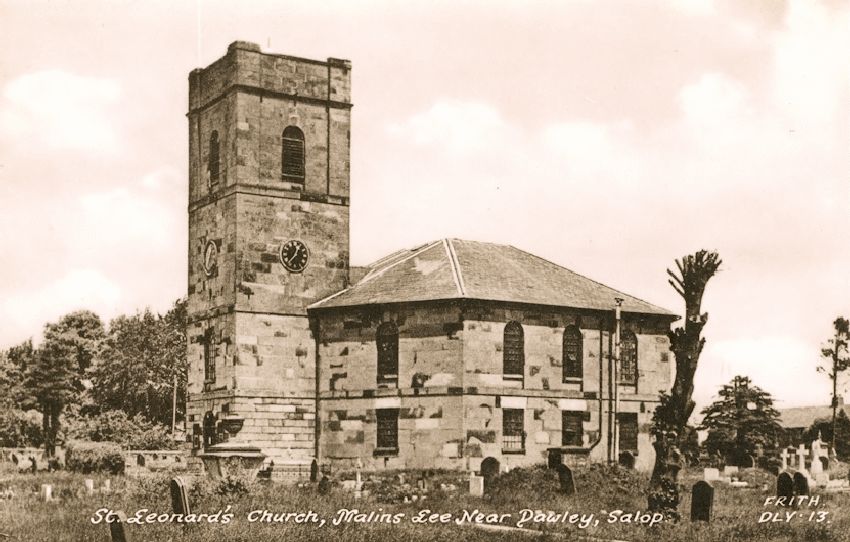
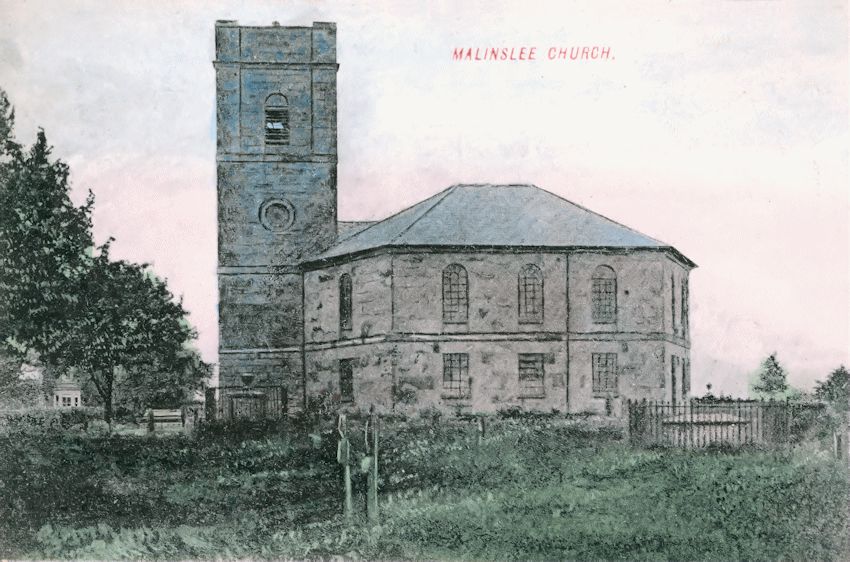
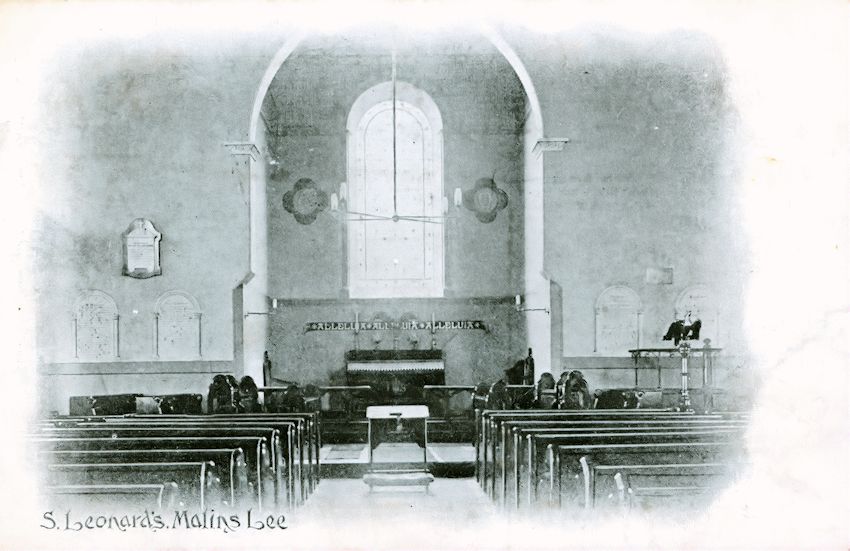
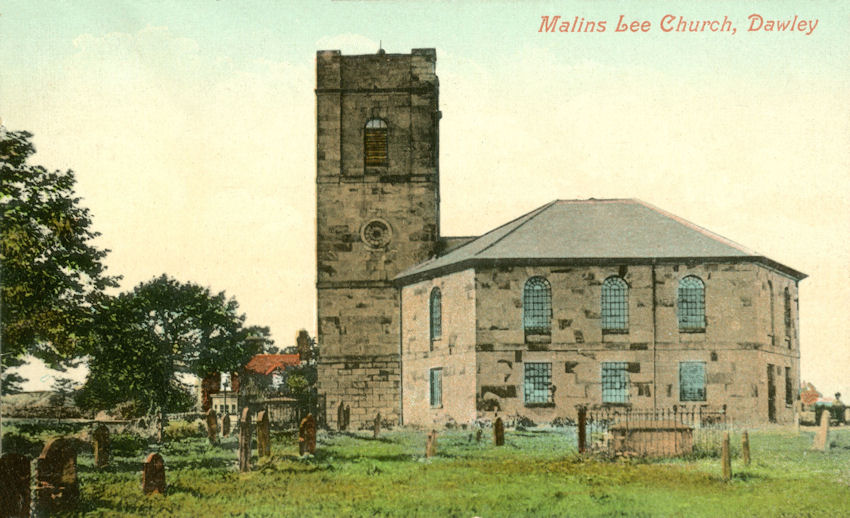
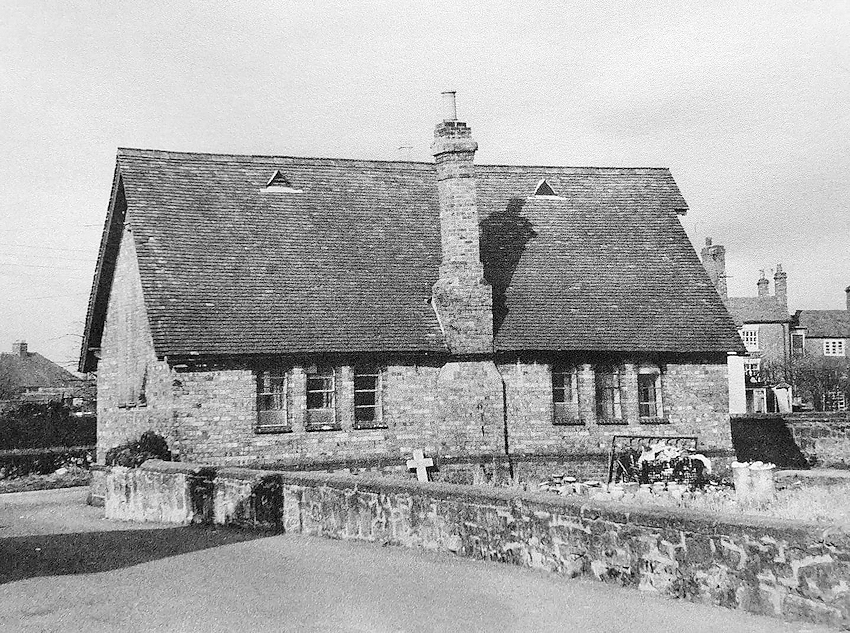
Malinslee Mission Room. (Photo from the internet)
Laying the Foundation Stone of the New Church Mission Room.
(On Monday 11th June 1883.)
The Wellington Journal Saturday 16 June 1883.
On Monday last, the ceremony of laying the foundation stone of a Mission Room in connection with St. Leonard’s Church, Malinslee, was performed by the Countess of Dartmouth, who had kindly undertaken the duty at the request of the respected vicar of the parish, the Rev. R. Woods. The want of such a room has long been felt by the parishioners as an obstacle to the proper working and administration of this populous district, and a place has been needed where the clergy could hold parochial meeting, &c. The accommodation afforded in the church vestry is so limited that meetings for classes and church work generally have hitherto frequently had to be held in private houses, or in places inconveniently distant from the mass of the population. The civil parish of Dawley is divided into three ecclesiastical districts, vis, Malinslee, of which the Rev. R. Woods is vicar; Dawley Magna, of which the Rev. R. C. Wanstall is vicar; and Dawley Parva, of which the Rev. R. Maltby is vicar. The population of Malinslee is larger than that of either of the other ecclesiastical districts, being at the last census 3,743, while that of Dawley Magna was 3,383, and that of Dawley Parva 2,072, While the area in acres is also considerably larger. The principal landowners in the parish are Mr. R. Cheney and Colonel Cure, of Badger. The church of Malinslee stands on the highest table-land in Shropshire, and forms a conspicuous object in the landscape from most parts of Salop and the surrounding counties. The view from it in the eastern and northern directions is most extensive, and it was incidentally mentioned on Monday by Mr. Owen Harries, who resides near the church, that from the grounds in front of his house, with the assistance of an ordinary glass, he has counted no fewer than 28 churches in the view ranging from Shifnal to Wolverhampton on the left, to Apley Terrace and Bridgnorth on south. In November last, the Rev. Gilbert L. James, vicar of Gresley, held a most successful mission in Malinslee, the church, which is a large octagonal building capable of seating 1,000 people, being crowded nightly. It was at that time that it was decided that a strong effort should be made to build a mission room as a memorial of the mission, and in furtherance of the object the following officials and committee were appointed: —Chairman, the Rev. R. Woods, vicar; vice-chairman, the Rev. E. Perry, curate; honorary secretary, Mr. Owen W. Harries; hon treasurers, the Rev. R. Woods and Mr. W. Summers, jun; auditors, Messrs, J. J. Bailey and J. S. Smith; committee, Mr. W. Summers Mr. F. H. Davis, Mr. T. T. Wynne, Mr. W. H. Bailey, Mr. J. Davenall, Mr. G. Robinson, Mr, Roden, Mr. john Bailey (Old Park), Mr. Preatwood, Mr. Roberts, Mr. Candlin, Mr. J. Thompson, Mr. W. Corbett, Mr. W. Jones, Mr. A Bishop, Mr. J. North, Mr. T. Jones, and Mr. O. Guest. The project was warmly taken up by the parishioners, and the energetic efforts of the promoters received liberal support, amongst the first subscribers being Colonel Cure, Mr. W. O. Foster (Apley Park), Mr. E. Chaney, Viscount Newport, M. P., and Mr. Stanley Leighton, M. P. Up to Monday, subscriptions had been already received amounting to £160, and it is proposed to hold a bazaar in September under most distinguished patronage. As architect, the services were called in of Mr. Joseph Farmer, of Brockton near Shifnal, who prepared plans of a building the cast of which, with the necessary furniture, is estimated at £420. Mr. J. Lavender, builder, of Dawley, is the contractor for the erection of the new Mission Room, which is to be built of red brick, with blue-brick window heads and plinths. The size of the large room will be 36ft. by 20ft., and that of a smaller room 13ft. by 12ft. The interior of the building will be colour-washed, with pained dado 5ft. high from the floor. The roof will be ceiled across at the collars, and a bell provided in the gable. Dale and Co’s ventilators will be used, and ventilation will be provided for in the roof. The whole of the work is expected to be finished in about six weeks.
The weather on Monday was delightfully fine, and large numbers assembled to witness the interesting ceremony, which was most successfully carried out. On the site of the new building, which is near the entrance to the churchyard, profuse decorations were visible, and flags and banners inscribed with suitable mottoes were to be seen in every direction, whilst a large frag floated from the tower of the church. Over the entrance gates of the church was a large banner with the motto, “Welcome to our Bishop.” and in the centre of the new site another banner, inscribed “welcome to Lady Dartmouth.” An improvised platform erected on the site was charmingly adorned with a number of choice plants and flowers. The Lord Bishop of Lichfield met the clergy in the vestry of St. Leonard’s at a quarter to 12 o’clock, soon after which time the bishop and clergy, attired in their surplices, and preceded by the surpliced choir, marched in procession to the site of the new building, singing the hymn. “March march onward, Christian soldiers true.” Amongst the clergy present were the following: —The Revs. R. Woods, vicar of Malinslee; E. Parry, curate of Malinslee; Prebendary Allen, Eccleshall; canon de Bunsen, Donington; T. B. Paynter, Kemberton; G. Todd, Wrockwardine Wood; T. R. J. Fawkes, Wellington; F. Burd, Neen Savage; W. B. Garnett-Botfield, Decker Hill; G. H. White, Lawley; T. Owen, Ketley; G. Edmonds, Little Wenlock; R. C. Wanstall, Dawley; W. J. Price, Lilleshall; E. F. Wanstall, St. Paul’s, Wolverhampton; C. Mousley, Stirchley; W. P. Alford, Dawley; J. C. Roberts, Ryton; C. P. Isaac, Boningale; G. W. Morrison, Heath Town, Wolverhampton; R. Wakefield, Shrewsbury; J. A. Panter, St. George’s; J. D. Daniels, Beckbury; R. Maltby, Dawley Parva; C. R. Bradburne, Sheriffhales; G. L. James, Gresley; &c, &c.
On arriving at the site, a beautiful bouquet of flowers was presented to the Countess of Dartmouth by Miss May Woods, daughter of the vicar. The Lord Bishop having offered prayer, the Rev. R Woods, in a few well-chosen words, handed to Lady Dartmouth a handsome silver trowel, on which was engraved — “Presented to Lady Dartmouth at the laying of the foundation stone of Malinslee Mission Room, June 11th, 1883.” Her Ladyship then proceeded with the ceremony, declaring the stone to be well and truly laid in the name of the Father, and of the son, and of the Holy Ghost. The chois having chanted the 122nd Psalm, “I was glad when they said unto me, We will go into the house of the Lord,” the Bishop addressed the assembly. His lordship said it was with very great pleasure that he complied with the request of their vicar to come and take part in the interesting and important ceremony in which they were now engaged, for it was to him one of very great interest, and it was to them one of very great importance. The history of the building was one which it would be well for him to recount for a few moments. They were all aware that in that neighbourhood a mission was held at the close of last year, and the building now being erected was really the outcome of that mission. It was the fruit of that stirring up of the hearts of people in that place which followed upon the efforts made by God’s grace to bring His Gospel home to the hearts of many in that neighbourhood. They desired to have a place where they might gather together to be instructed in the ways of God, and for many purposes which might be helpful to them in their spiritual life which could not well be fulfilled within the walls of the parish church, and of their freewill offerings they gave most liberally to assist in this excellent work: so they hoped that in time to come the building would be continually occupied for the gathering together of God’s people within its walls, that they might hold Christian fellowship one with another, and stir each other up to greater earnestness in their spiritual life. After speaking at length on the importance of missions, his Lordship referred to the question of intemperance, and the change which had come over public opinion in regard to it. In his own lifetime he could remember when it was thought nothing objectionable for a gentleman to be seen drunk after dinner. Now it was considered an utter disgrace, and a gentleman addicted to excess dare not show himself in educated society. Amongst the humbling classes, it was thought no disgrace to see a man tumbling home from the public-house. It was laughed at, and looked upon as a good joke. A good joke! — why, it was a sin that destroyed both body and soul. But here there had been a wonderful improvement in his own lifetime, and he hoped soon it would be looked upon as being as great a disgrace for working man to be seen drunk as it was for a gentleman. He trusted when he came again to hear from their minister that many had been reclaimed from the degrading sin of drunkenness, which was the curse of the land. The blue ribbon, however, was not the sole passport to heaven. A man must be sober to hear and receive the Word of God, but he must not rest content with being sober. The Bishop concluded by expressing the hope that many a home in that neighbourhood, now made miserable by the drunkenness of the husband, or, still worse, by that of the wife, would become like a light spot in the parish, not only a blessing in itself, but a centre of blessings to all around it — His Lordship then pronounced the Benediction, and afterwards made an appeal for liberal contribution towards the building fund, saying they not only wanted the pounds of the rich, but the pennies of the poos, so that a working man when passing the building might be able to say, “Ah I had a hand in that.” — The hymns, “The Church’s one Foundation” and “All people that on earth do dwell.” were then sung, during which a collection was made in aid of the building fund, about £65 being contributed.
The company subsequently adjourned for luncheon, which was laid out in a commodious tent on the Vicarage grounds. The interior of the tent was tastefully decorated with evergreens, flowers, and shield-shaped bannerets, on which were the mottoes “Fear God,” “Honour the Queen,” “Love the brotherhood,” “Honour all men,” “Success to our schools.” Outside were banners inscribed “God guard our Church and guide our Queen,” “Malinslee Church Sunday Schools,” “Knowledge is power,” “Unity is strength,” “Onward,” &c., &c. The luncheon — a most recherche one — was presided over by the Lord Bishop, including the Countess of Dartmouth, Lady Meyrick, the whole of the clergy who had taken part in the proceedings, and a number of the laity. At the conclusion of the repast.
The Rev. R. Woods, in a few brief sentences, expressed his hearty gratitude to Lady Dartmouth for her kindness in coming amongst his people. The day had been looked forward to with much interest, and would ever be remembered as a red-letter day in the history of the parish. The effort they had made had evoked the sympathies of rich and poor, as shown by the immense gathering to witness the interesting ceremony. The Vicar alluded to the great advantage to be found in the various classes of our country meeting together and combining in common Christian work. He was assured that the working classes of the district have on truer friends than the Bishop of the Diocese and the noble lady who had honoured the parish with her presence and helped the work carried on. (Loud applause.)
The Rev. Canon de Bunsen said that Lady Dartmouth had asked him to return in her name for the very kind way in which Mr. Woods had proposed his thanks to her for the kindness she had shown in coming forward to lay the foundation stone of the Mission Room in that parish. In her Ladyship’s presence he could not say all he should wish to say about her; but he would just say this—that if there was a lady in England who desired not only to do her duty, but to give pleasure to others, it was Lady Dartmouth. (Loud applause.) From the most friendless little girl to the highest in the land, her ladyship was always ready to lend her aid, to cheer the downcast, to help the fallen, and raise them up to the height to which our Lord and God would like to see them. In her ladyship’s name he was desired to say she was thankful to have been there that day, and she hoped the Mission Room would prosper and be a source of blessing to all around. (Applause.)
The Bishop, in responding, said he was only doing his duty in coming there on that occasion, and it was a great happiness to him to be allowed to be present that day. He did wish to add his testimony to what had been said about Lady Dartmouth’s unfailing readiness to assist in all good works. (Hear, hear.) Her ladyship helped him in every possible way. He only wished he had a thousand Lady Dartmouths in his diocese, and then the diocese would prosper a thousand-fold. (Applause.) There was no good work in which he had asked her assistance but what she was more ready to give it than then he was to ask her. The present was only one of the great many instances of her ladyship’s readiness to help forward any good cause. (Applause.)
The guests soon afterwards left the table. At three o’clock a children’s service was held in the church, when interesting addresses were delivered by the Rev. Gilbert L. James and Rev. R. Woods.
A second stone was laid at four o’clock by the Re. Gilbert L. James, mission preacher, the primary instigator of the scheme for erecting the Mission Room. This ceremony commenced by the Vicar giving out the hymn, “There is a happy land,” which was very pleasingly sung by the school children. Having offered prayer, the Vicar gave a short address, in which he referred to the pleasure which had been expressed both by the Bishop and Lady Dartmouth at the proceedings of the day. Although the present was an occasion of gladness, it had been to him not unmixed with sadness. When they first started to make arrangements for the Mission Room there was one working with him in the parish whose loss he should feel as long as he stayed there. He referred to Miss Harris. He should never think of the Mission Room without thinking of her who had taken so much interest in it, and who, if she had been spared, would have worked with all her heart and soul to have done good to her neighbours and to help on the cause of Christ. Mr. Woods concluded by saying it afforded him great pleasure to see so many working men present, on whose behalf he was ready to spend and be spent, and he could assure them there was no one who had more at heart the interests of the working classes than Lady Dartmouth and the Bishop of the Diocese. So great was the interest taken in them by the Bishop, that he mentioned it to him (the speaker) that he should like to come down at a future time and address the working men of that neighbourhood. — Nine little girls, attired in white, then ascended the platform, when Miss May Woods, on behalf of the Sunday-School children, presented to Mr. James a beautiful silver trowel, on which was engraved— “Presented to the Rev. G. L. James, as a memento of the 11th of June, 1883. Malinslee.” The trowel had been purchased with 420 pennies subscribed by the children of the Sunday-Schools. The Rev. G. L. James having suitably returned thanks for the presentation, laid the stone in the usual way, and afterwards delivered an earnest address, concluding by placing upon the stone a contribution from his own congregation, and making an appeal for a good collection. — Hymns were sung and a collection made.
At half-past five o’clock upwards of 300 parishioners and friends partook of an excellent tea in the tent.
A special service was held in the church at seven o’clock, the preacher being the Rev. Gilbert L. Jamse.
The total of the day’s collections, including donations sent to the Vicar by friends unable to attend, was £100.
Opening of the Church Mission Room, Wednesday 31st Oct 1883
Wellington Journal, Saturday 03 November 1883
It will be remembered that the foundation stone of this building was laid by the Countess of Dartmouth on the 11th June last with great éclat. The Bishop of the Diocese preached on the occasion, and over £100 was collected. Since then the Very Rev. the Dean of Lichfield has pleaded for the same object. This building, the first idea of which was suggested by the mission held by the Rev. G. L. James, a year ago, is now completed. It was built by Mr. J. Lavender, after plans by Mr. Joseph Farmer, architect, of Brockton, Shifnal. It has a very Pleasing external appearance, is well warmed and ventilated, and admirably suited for the purposes for which it is intended. The interior is divided into two rooms—the larger being 36ft. by 20ft., and the smaller 20ft. by 12ft. There is also a neat entrance porch with the inscription over the door:— “St. Leonard’s Church Room.” The room is tastefully painted and decorated, and well lighted with gas. At the upper end of the main room is a platform, and both rooms are well furnished with chairs, cupboards, &c. Hanging on the wall is a lovely proof engraving of Sir Noel Paton’s famous picture of the Good Shepherd, kindly presented by a lady friend of the vicar’s as a dying gift. The building is intended to be used for week-day services, social gatherings, Church meeting, Bible classes, evening lectures, children’s services, mothers’ meetings, &c. The building is provided with a bell. The opening ceremony took place on Wednesday last, at 3 p.m. when a short dedicatory service was performed. The Vicar (Rev. R. Woods) read the prayers. The first lesson was read by the Rev. R. C. Wanstall (vicar of Dawley Magna), and the second by the Rev. E. Parry (curate of Malinslee or Dawley Nova). The prayer of consecration was read by the Right Rev. Bishop Bromby, D.D., who afterwards preached a most eloquent and impressive sermon from Acts xi. 23. Among the clergy present were Rev. Prebendary de Bunsen, rural dean (who has throughout taken a very kind interest in the work); Rev. A. P. Salusbury, vicar of Wrockwardine; Rev. J. A. Panter, vicar of St. George’s; Rev. G. Todd, rector of Wrockwardine Wood; Rev. C. Mousley, rector of Stirchley; Rev. H. L. Graham, vicar of Buildwas; Rev. R. B. Atty, vicar of Priorslee; Rev. G. H. White, vicar of Lawley; Rev. G. L. James, vicar of Gresley; Rev. W. P. Alford, curate of Dawley Magna. A collection was made at the close in aid of Home Missions. At five o’clock a public tea was held when about 120 sat down to a substantial repast, supplied by Mrs. Shingler. The room, brilliantly lighted up, decorated with plants, flowers, &c., presented an animated appearance. The work of decoration was kindly undertaken by Miss. Ibbs. The trays were given by the following: — Mrs. Woods, Mrs. Owen Harries, Mrs, Summers, Mrs. Davies, Mrs. Davenall and Mrs. Huffadine, Mrs. Gilbert, Mrs. W. H. Bailey, Mrs. Maddock, Mrs. J. Bailey (Old Park), Mrs. Robinson, and Mrs. Roberts. The following gave half-trays: — Mrs. Smith, Mrs. Prestwood, Mrs. W. Jones, Mrs. Vaughan, Mrs. Ibbs, Mrs. Rushton, Mrs. S. Callear, Mrs. Langford, Mrs. Tomlins, Mrs. W. Corbett, Mrs. Candlin, Mrs. S. Hayward, Mrs. E. Bailey, Mrs. J. North, and Mrs. Shingler. After the tea, a meeting was held, with Rev. R. Woods (vicar) as chairman. The room was crowded, some having to stand. The meeting was opened with prayer by the Vicar. The following clergymen gave addresses: —Rev. J. A. Panter, Rev. G. H. White, Rev. T. Owen, and Rev. R. B. Atty. The closing address by the Rev. G. L. James, from 1 Corinthians iii. 12—15, was very impressive. The missioner exhorted his hearers to earnest Christian work and vital religion. The programme of sacred music, was as follows: —Anthem, “O, be joyful in the Lord;” hymn, “Happy they who trust in Jesus;” anthem, “Rejoice greatly,” with chorus; hymn, “Rescue the perishing;” anthem, “If ye love Me;” hymn, “O, think of the home over there.” The meeting was felt to be a most enjoyable and profitable one by all present, and hearty good wishes for the success of the room were generally expressed. A good harmonium is still required, and also gifts of sacred pictures for the walls. —It will be seen from advertisement that the Rev. G. L. James has kindly consented to preach, morning and evening, to-morrow (Sunday), and to give an address in the Mission Room in the afternoon; subject, “A Bunch of Flowers.”